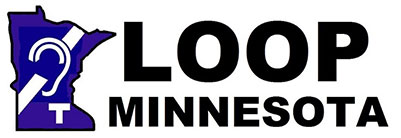Where and How Can Hearing Loops Help?
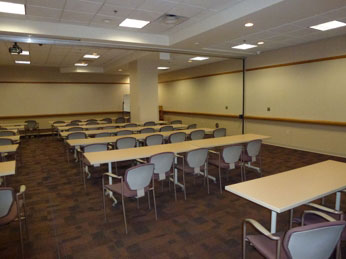
Hearing loops are especially effective in large rooms or conference halls where audiences listen to speakers who talk into microphones. In such places, background noise, reverberations and echoing make the understanding of speech virtually impossible, particularly for those with hearing loss. Even hearing aids and cochlear implants may not be enough for understanding speech in these complicated sound environments.
Also, PA (Public Address) systems that are often turned up quite loud in an attempt to have people hear better can create distortion and end up overloading an already challenged hearing system. Louder is often not better, as those who are hard-of-hearing well know.
By listening through a hearing loop, the speaker’s voice that comes through the microphone is isolated. Background sound and echoes are greatly reduced, if not eliminated. Listening becomes easy. And that is why people love loops.
Therefore, Hearing Loops are of benefit in places of worship; museums; offices and conference rooms at work; presentation rooms in libraries; classrooms; auditoriums; convention halls and more. They also work well at information desks in loud places, such as train stations and airports. That said, hearing loops can also be installed for personal use in homes, dens and even in cars.
What is a Hearing Loop? What are Telecoils or T-Coils?
A hearing loop – also called induction or audio loop – is an assistive listening system that makes it easier for the hard-of-hearing to understand speech in background noise.
The “system” consists of the basic loop set-up (see description below) and tiny wireless antennas called T-coils or telecoils. These antennas are standard equipment in cochlear implants (CIs) and in most hearing aids that are roomy enough to accommodate them.
However, in order to be of use, Telecoils must be “activated” by the hearing specialist. They are tuned to the person’s hearing loss. To listen to a hearing loop, Telecoils have to be switched into the T position or mode.
Loop and Telecoils work as a Team. One without the other is useless for better hearing and understanding.
Parts of a Basic Hearing Loop Setup
A basic induction/hearing/audio loop has 3 parts:
- an electrical wire (the loop) that is installed around or throughout the area to be made accessible
- an electrical current amplifier (not voltage)
- a sound source, such as a microphone, TV, MP3 player etc.
The Basics of How a Hearing Loop Works
Linking the Loop and the Telecoils:
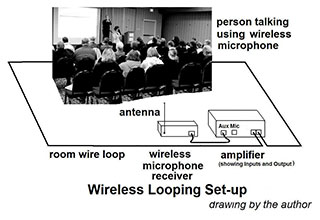
Hearing Loop designs are adapted to the space to be made accessible. For ease of understanding how a loop works, this diagram shows a basic Perimeter Hearing Loop. People with telecoils in their hearing instruments or with Loop Listening Devices (receivers) will be able to hear the presenter clearly without background noise. Diagram from the book: “What Did You Say?” by Monique Hammond
About the Diagram: Steps to hearing through the loop
- The loop wire is placed so that it surrounds the audience. People sit or stand inside the loop.
- The speaker speaks into the microphone. The microphone signal is received by the antenna of the wireless microphone receiver, which is connected to the electrical current amplifier. The loop wire also connects to the amplifier.
- As the speaker speaks, electricity flows in the loop wire. As electricity flows, a magnetic field forms around the loop wire. The intensity of the magnetic field determines how loud the loop sound signal is. It is adjusted by means of the current amplifier.
- In a “looped” environment, the user switches the hearing aids or cochlear implant (CI) into T-mode. This disengages the hearing aid or cochlear implant (CI) microphones and engages the telecoils.
- The Telecoils tap into the magnetic field and feed a sound–source-only signal to the hearing aids or CIs, which process the sound. The user can further adjust the volume on the hearing aids, CIs or loop receivers.
In other words: What goes into the microphone, such as the voice of a speaker, goes to the hearing instruments. As background noise and echoes are virtually eliminated, speech that could sound garbled becomes a lot clearer and understandable.
Hearing loops can also be connected to existing Audio-Visual (AV) systems so that all the information presented at a venue is accessible via telecoil. One might be thinking of video clips during a presentation.
Important Note: Upon leaving a looped venue, switch the hearing aids or cochlear implants OUT OF Telecoil mode and back into the Microphone mode. If left in the incorrect setting, people may think that their hearing devices do not work anymore because the microphone(s) remain shut off.
Listen to a Loop Sound Demonstration
Hear the difference with and without a loop in the very noise-intense environment of a New York City subway station:
How Do I Know if a Venue Has a Hearing Loop?
Looped facilities display a sign similar to one of those below. Although colors may vary, they usually have a dark colored background with white lettering.
Note: The “T” stands for “Telecoil” and is the important feature of any hearing loop sign.
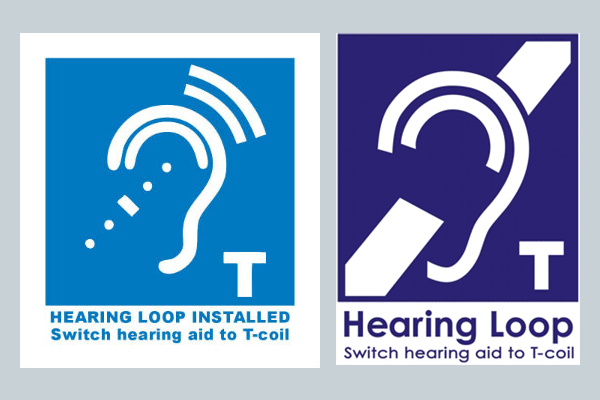
The sign on the right is referred to as the “International Hearing Loop” sign.
The sign on the left denotes Assistive Listening Access for hearing loss. Again, the “T” signals the presence of a hearing loop.
The Telecoil Issue: Do I Have Those?
As stated earlier, Telecoils or T-coils are small, wireless antennas that are standard equipment in cochlear implants (CIs) and in most hearing aids that are large enough to accommodate them.
The trouble is that many, if not most hearing aid users do not know if they have telecoils in their hearing aids. Maybe the issue never came up during their visits with the hearing specialist.
However, for telecoils to work with a loop, they must be activated by the hearing aid vendor. Usually, hearing aids with telecoils have a T-switch on them or maybe an M/T switch. In M/T mode, the listener can hear through the loop while also remaining aware of other sounds. Other hearing aids may have a voice-indicator telling the users which memory (program) they are tuned to. Upon clicking the memory button, the voice may say something like: Master; Comfort or Telecoil. If the telecoil choice is not among the listings, the instrument either does not have a telecoil or it is not activated.
So, it is important to inquire about Telecoils with the hearing instrument specialist. In order to make good decisions, people must have all the facts and relevant information.
That said, telecoils are also available in portable devices for those who do not have them in their hearing aids. In that case, earbuds or headphones are needed in order to access the loop. This also means that one does not have to have hearing loss or hearing aids in order to listen to a hearing loop as long as one has a telecoil-equipped device.
Bluetooth or Telecoil?
At this time, people no longer have to “choose” between Telecoil or Bluetooth.
Many newer hearing instruments offer both telecoil and Bluetooth. These are two great technologies that help in different ways.
So far, Bluetooth for hearing aids is proprietary technology. It enables close-up, wireless connections with other compatible Bluetooth-equipped devices, such as smartphones, computers, TVs etc. The devices must be “synched” with the hearing instruments. And so, it is important to ask about compatibility or the need for streamers or adapters etc. at the time of sale.
However, the Bluetooth version for hearing instruments does not help with improved hearing in large, noisy places the way the loop/telecoil system does.
Unlike Bluetooth, Hearing Loop technology is not proprietary and works worldwide with any hearing or other instruments that have telecoils.
And so, how much technology does the client need or want? This shows that it is important to learn about the different models of hearing aids and to ask the hearing specialist about these two technologies in order to benefit from both. People must know about ALL of their choices in order to make good decisions.
Go to our Bluetooth page to read more about the Bluetooth and telecoils discussion.
What if a Venue Does Not Have a Hearing Loop?
We can “loop” ourselves with a neckloop. This is an insulated personal miniature induction loop wire. Worn around the neck, it can be hidden under a shirt and need not be obvious. It works on the same principle as room loops do.
The neckloop has a plug that connects to a sound source, such as the TV, phone, computer or FM or IR receivers like those that are usually offered at places of worship or libraries.
In this case, the sound source energizes the neckloop. Telecoils that are switched to T-mode on hearing aids or cochlear implants tap into the magnetic field and relay the sound-source signal to the hearing instruments.
Consult with a hearing specialist. Learn about different neckloop features so that you get a neckloop that works with your type of hearing aids or devices. Know the features of the neckloop. For instance, does it have to be recharged or do batteries have to be replaced?
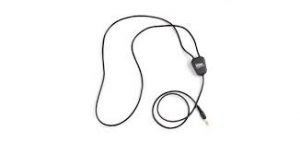
Neckloops are also used in order to make assistive receivers such as those available in churches, libraries or at conference venues compatible with hearing aids that have Telecoils – as per 2010 ADA Requirement: (this link is different from the previous one)
From the ADA text: “…The 2010 Standards at section 706 require assistive listening systems to have standard mono jacks and will require hearing-aid compatible receivers to have neck loops to interface with telecoils in hearing aids… “
You can read more about this under “Other Assistive Technology.”
Problems with Hearing Loops
Due to technical or construction issues, it may be impossible to install a hearing loop in a particular venue. Too much metal can drain and weaken the loop signal. Unwanted background crackling or buzzing noises are usual concerns.
Also, as the magnetic field from a perimeter hearing loop tends to “leak” outside of the looped space, privacy issues may require a more complicated loop design, known as phased array. It is important to cut down on the “spill” or anybody with a telecoil could listen in on conversations from an adjacent room or hallway. Here one might think of places like medical facilities and doctors’ offices, law offices and court rooms.
Although a phased array loop can cut the “spill” significantly, it adds an extra level of complexity to the installation and will increase the cost. Therefore, Privacy issues must be addressed with the installer ahead of time.
